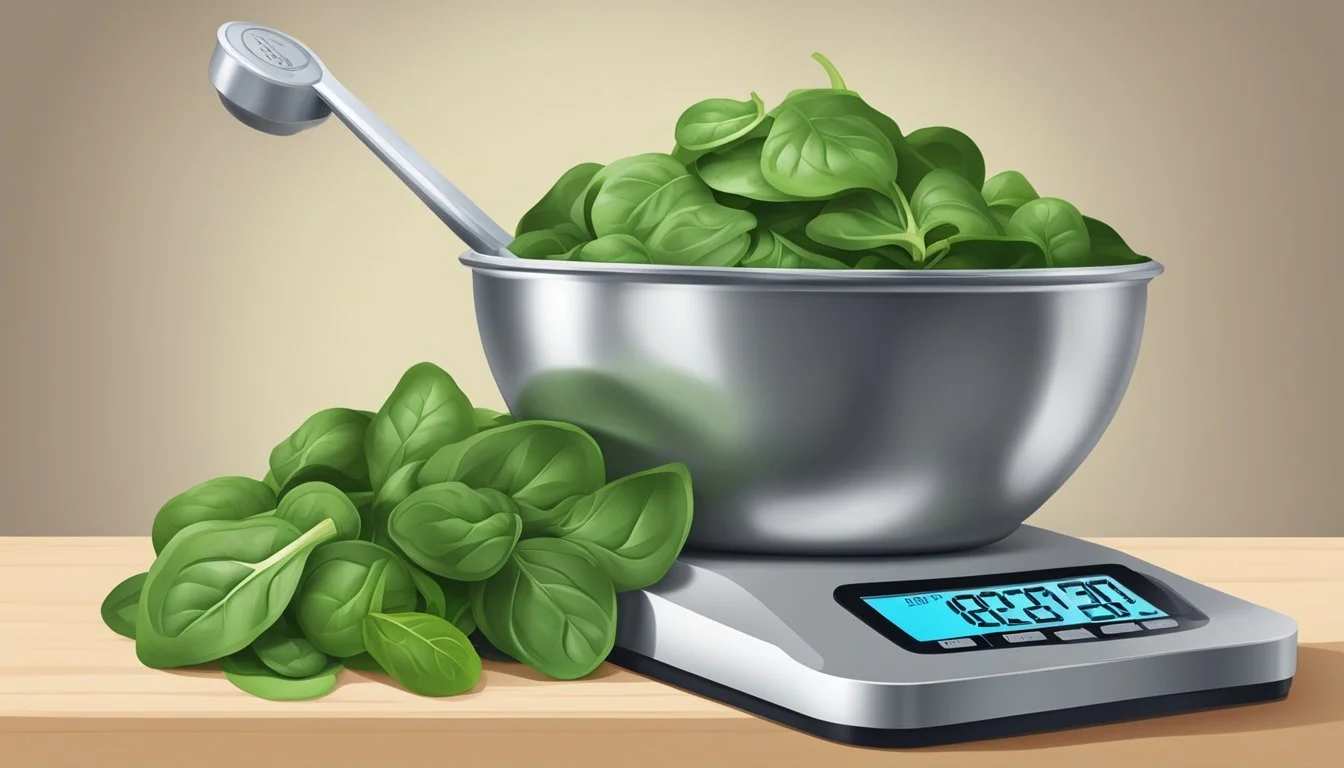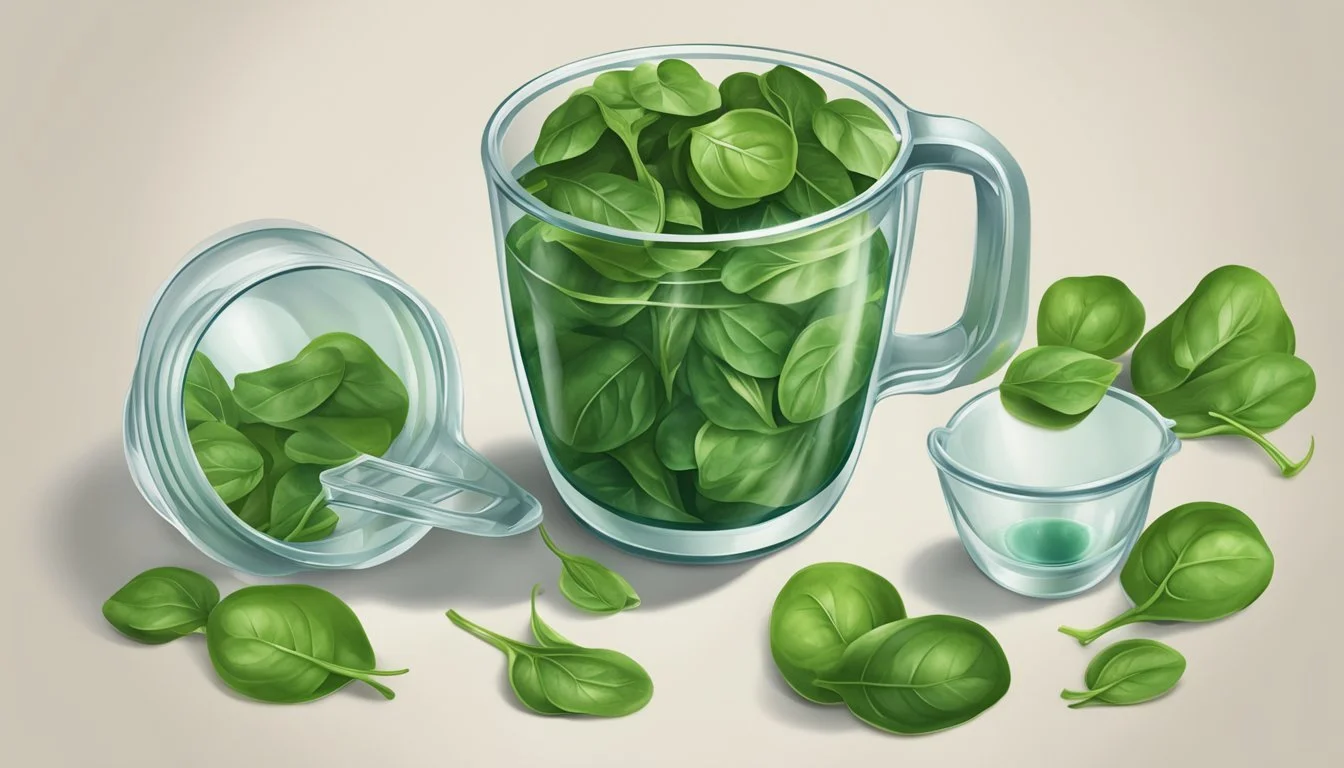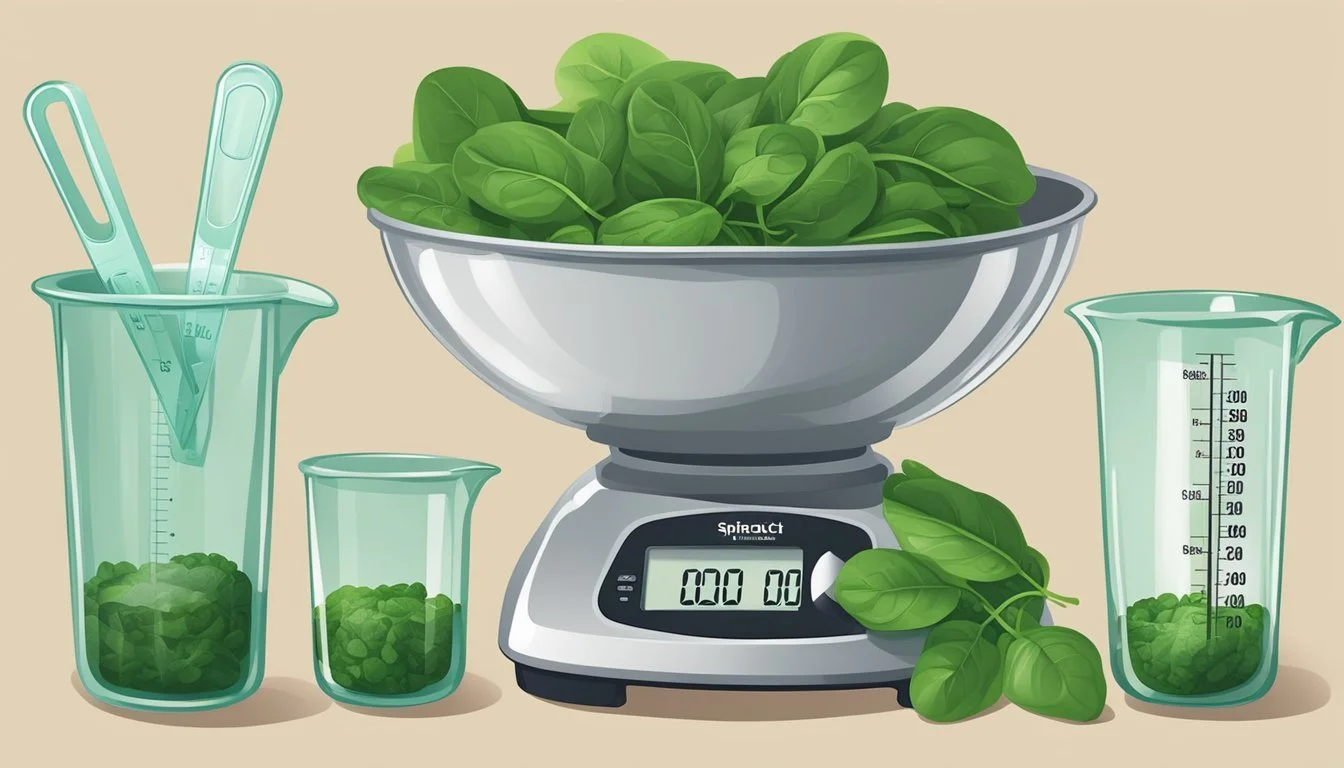How Many Cups in a Pound of Spinach
Accurate Measurements for Cooking
Understanding the conversion of spinach (What wine goes well with spinach?) from weight to volume is essential for both home cooks and professional chefs alike. When measuring spinach, the context of its state—whether fresh, torn, or cooked—can vastly influence the volume. A pound of fresh spinach typically translates to approximately 10 cups of raw leaves. This amount may vary slightly depending on the density and size of the leaves.
Since spinach reduces in size when cooked, the same pound of spinach will yield a significantly lower volume after being exposed to heat. Approximately 1 cup of cooked spinach is obtained from one pound of raw spinach, emphasizing the dramatic decrease in volume through the cooking process. A converter might be handy for those who wish to toggle between weight and volume measurements, ensuring precise proportions in their culinary endeavors.
The practicality of this conversion is apparent when following recipes that specify ingredients by weight or volume, aiding in accurate ingredient substitution and adjustment according to serving sizes. From shopping for the right amount of spinach to achieving desired results in a recipe, understanding the relationship between cups and pounds of spinach is a fundamental culinary skill.
Understanding Measurements
When quantifying spinach for recipes, it's crucial to distinguish between weight and volume, recognizing the impact of density and packaging on these measurements.
Weight Versus Volume
Weight is a measure of heaviness, with spinach commonly sold by the pound (lb). One pound is equivalent to 453.6 grams or 16 ounces. Volume, on the other hand, measures the space an ingredient occupies, typically in cups. Leafy vegetables like spinach present a challenge as their volume can vary significantly depending on whether the leaves are whole, chopped, sliced, or diced. This can lead to discrepancies when converting from weight to volume.
Fresh spinach: 1 pound ≈ 10-12 cups (whole leaves)
Cooked spinach: 1 pound ≈ 3/4 to 1 cup
Density varies between fresh and frozen spinach. Fresh spinach is more voluminous with air between the leaves, while frozen spinach is typically denser and occupies less volume due to reduced air and moisture content.
Spinach Density and Packaging
The weight-to-volume conversion of spinach depends heavily on its density, which is influenced by packaging. Densely packed spinach, often found in frozen packages, yields less volume per pound compared to loosely packed or fresh varieties.
Fresh spinach: Sold in bunches or loose leaves, less dense
Frozen spinach: Sold in compressed blocks or bags, more dense
For example, 10 ounces of frozen spinach can equal about 1-1/2 cups after cooking, while the same weight in fresh spinach yields much more before being cooked. Consumers should note that a package stating "10 ounces of frozen spinach" does not equate to 10 ounces of fresh spinach in volume when cooked.
It's important to consider that fresh spinach significantly wilts and reduces in volume when cooked, hence the substantial difference between cups of raw versus cooked spinach from the same weight.
Spinach Varieties and Their Impact on Weight
The weight of spinach is influenced by its variety and whether it is fresh or frozen, as these factors affect spinach's density and moisture content.
Fresh Versus Frozen Spinach
When measuring spinach by weight, it's essential to distinguish between fresh and frozen spinach. Fresh spinach typically has a higher volume for its weight; one pound of fresh spinach can translate to about 10 cups of loose leaves. In contrast, frozen spinach is denser and has most of the water removed, resulting in a significantly reduced volume.
Fresh Spinach: 1 pound ≈ 10 cups (loose leaves)
Frozen Spinach: 1 pound ≈ much less than 10 cups (compressed)
Different Types of Spinach
Spinach is available in a few varieties, mainly savoy, semi-savoy, and flat-leaf, each with unique characteristics.
Savoy spinach has crisp, curly leaves and a robust texture, often preferred in cooked dishes where it maintains its shape.
Semi-savoy spinach is a cross between savoy and flat-leaf, offering a balance of texture and easier cleaning due to less wrinkled leaves.
Flat-leaf spinach includes baby spinach, known for its smooth leaves, tender texture, and a milder flavor, ideal for salads.
Variety Description Texture Flavor Savoy Curly, dark green leaves Crisp Rich Semi-Savoy Less curly, easier to clean Less crisp Milder than savoy Flat-Leaf Smooth, broad leaves Tender Mild Baby Spinach Young flat-leaf spinach, smaller in size Very tender Mild and sweet
It should be noted that each variety can impact the weight-to-cup conversion slightly because of their differing leaf structure and density.
Conversion Guidelines
Accurate conversions between cups and pounds of spinach are vital for preparing dishes like salads, soups, quiches, (What wine goes well with quiche?) casseroles, and pasta that include spinach. These guidelines provide clarity on how to measure spinach correctly for various recipes.
Cups to Pounds Conversion Chart
Below is a conversion chart for understanding the quantity of spinach needed when a recipe specifies weight (pounds) but measuring in volume (cups) is preferred.
Pounds of Spinach Cups of Raw Spinach (Approx.) 1/4 lb 2.5 - 3 cups 1/2 lb 5 - 6 cups 3/4 lb 7.5 - 8 cups 1 lb 10 - 15 cups
This chart acts as a handy reference but note that the volume may vary depending on how tightly the leaves are packed.
Common Recipe Measurements
When using spinach in recipes, typical measurements are in cups. To facilitate accurate preparation, the following are standard conversions used in most spinach recipes:
Salads: Often call for 4 to 6 cups of raw spinach, which is roughly 1/3 to 1/2 pound.
Soups and Casseroles: May require about 1 cup of cooked spinach, equivalent to approximately 1 pound of raw spinach due to significant reduction upon cooking.
Quiches and Pasta Dishes: Typically range from 1 to 2 cups of cooked spinach, necessitating about 1 to 2 pounds of raw spinach.
These measurements ensure the correct spinach yield for the desired food consistency and flavor profile. It's important to remember that a pound of raw spinach can yield substantially less when cooked, as it wilts down significantly. Websites with a spinach converter can also be used for more precise measurements tailored to specific recipes.
Preparing Spinach for Recipes
When preparing spinach for recipes, one must ensure that the leaves are thoroughly cleaned and properly cut to maintain the food's texture and health benefits. These initial steps set the stage for delicious and nutritious dishes whether the spinach is served raw or cooked.
Washing and Drying Techniques
Washing Technique:
Place spinach in a large bowl of cold water.
Swirl leaves around to loosen and remove dirt.
Lift spinach out of the water, allowing dirt to remain at the bottom of the bowl.
Repeat this process until the water remains clear.
Drying Technique:
Lay out the leaves on a clean kitchen towel or use a salad spinner.
Gently pat the spinach dry if using a towel, ensuring not to bruise the leaves.
Storage Tip:
If not using immediately, store the cleaned and dried spinach in the refrigerator in a container lined with paper towels to absorb excess moisture and promote airflow. This maintains the leaf's crisp texture.
Cutting and Chopping Methods
Removing Stems:
Grip the stem with one hand and strip the leaf away with the other for whole leaf use.
For chopping, slicing can be inclusive of tender stems.
Chopping and Slicing:
For chopped spinach, stack leaves and cut into desired size with a sharp knife.
Sliced spinach is often used for more delicate presentations; roll leaves into a tight bundle and slice thinly crosswise.
Cooking Note:
Keep in mind the volume of spinach reduces significantly when cooked, with one pound of raw leaves yielding approximately one cup once cooked. Adjust the quantity based on whether your recipe calls for raw or cooked spinach.
Health Benefits of Spinach
Spinach is a nutrient-dense vegetable offering numerous health benefits. It provides a considerable amount of vitamins and minerals while being low in calories, making it an integral part of a balanced diet.
Nutritional Value Per Pound
Nutrient Amount Per Pound (raw) Calories Approx. 104 kcal Protein Approx. 12.9 grams Fat Approx. 1.8 grams Carbohydrates Approx. 16.1 grams Fiber Approx. 9.8 grams Vitamin A Significant Amount Vitamin C Significant Amount Vitamin K Significant Amount Folate Significant Amount Iron Significant Amount Potassium Significant Amount Magnesium Significant Amount
A pound of spinach provides essential nutrients such as iron, which supports blood health, and folate, critical for DNA production and cell health. Its high fiber content aids digestion, and the presence of vitamins A and C, along with potassium and magnesium, support overall body functions.
Incorporating Spinach into a Balanced Diet
Incorporating spinach into one's diet can be easily achieved through various culinary applications. Whether added to salads or blended into smoothies, spinach's versatility makes it ideal for boosting the nutritional content of meals and beverages. Providing health benefits with minimal calories, it pairs well with fruits, vegetables, and proteins to create healthy, balanced dishes. Furthermore, its richness in vitamin K is essential for bone health, while the combination of nutrients found in spinach contributes to maintaining a healthy lifestyle.
Alternative Spinach Uses and Substitutions
While spinach is commonly recognized for its role in a variety of dishes, its versatility extends beyond traditional culinary uses. It can be substituted effectively for similar greens in recipes, and also used in innovative, non-edible ways.
Spinach in Non-Culinary Contexts
Spinach can be creatively incorporated into decorative and edible arrangements. Its vibrant green leaves add a lush aesthetic to garnishes and centerpieces. Spinach's texture and flavor profile do not alter significantly when used decoratively, maintaining its integrity.
Substituting Spinach in Recipes
When cooking, substitutes for spinach hinge upon comparable texture and taste. Kale and Swiss chard are excellent replacements, with kale providing a slightly more robust flavor and heartier texture. To match the flavor of spinach, use beet greens, which are softer and blend seamlessly into dishes. Here's a quick reference for substituting spinach:
Kale: Best used in cooked dishes due to its firmer texture.
Swiss Chard: Similar to spinach with a slightly stronger taste.
Beet Greens: An ideal substitute for cooked spinach, sharing a similar texture.
To substitute fresh spinach with these alternatives, one should consider the following conversions:
1 pound fresh spinach = 2-3 cups raw beet greens or Swiss chard.
1 pound fresh spinach = 2 cups raw kale, due to its denser leaves.
When substituting, it's important to note that cooking times may vary, and one should adjust to achieve the desired texture and flavor intensity.
Storing and Freezing Spinach
Proper storage techniques are crucial to extending the shelf life of spinach, ensuring both its freshness and food safety. Two main methods for preserving spinach include refrigeration for short-term use and freezing for long-term storage.
Short-Term Refrigeration
For short-term storage, fresh spinach should be kept in the refrigerator. One should gently wrap the spinach in a paper towel to absorb excess moisture, which can accelerate spoilage. The wrapped spinach then goes into a storage container or plastic bag, which is sealed tightly to retain freshness. It is advisable to store the package in the crisper drawer of the refrigerator, where the temperature and humidity levels help preserve the spinach. This method generally maintains the quality of spinach for about 10 days.
Steps for Refrigeration:
Absorb excess water with a paper towel.
Place wrapped spinach in a container or bag.
Seal and store in the crisper drawer.
Long-Term Freezing Techniques
For keeping spinach beyond the refrigerator's shelf life, freezing is recommended. Spinach can be frozen without blanching if used within six months, maintaining most of its nutritional content. However, for optimal food safety and quality, spinach is commonly blanched first. Blanching involves boiling the leaves for 1-2 minutes, followed by an ice bath to halt the cooking process. After draining and squeezing out excess water, the spinach is measured, typically in cups, and packed into freezer-safe bags or containers. Removing as much air as possible before sealing prevents freezer burn. Frozen spinach stored under the right conditions can last for up to 6-12 months.
Steps for Freezing:
Blanch spinach (optional for use within six months).
Cool in ice bath, drain well, and squeeze out water.
Measure and pack into freezer-safe bags or containers.
Remove air, seal, and label with date and contents.
Store at a consistent, low temperature.








